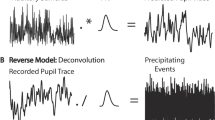Abstract
The same pattern of vestibular afferent feedback may signify a loss of balance or a change in body orientation, depending upon the initial head posture. To resolve this ambiguity and generate an appropriate motor response, the CNS must transform vestibular information from a head-centred reference frame into relevant motor coordinates. But what if the reference frame is continuously moving? Here, we ask if this neural transformation process is continuously updated during a voluntary change in head posture. Galvanic vestibular stimulation (GVS) was used to induce a sensation of head roll motion in blindfolded subjects marching on the spot. When head orientation was fixed, this caused unconscious turning behaviour that was maximal during neck flexion, minimal with the head level and reversed direction with neck extension. Subjects were then asked to produce a continuous voluntary change in head pitch, while GVS was applied. As the neck moved from full flexion into extension, turn velocity was continuously modulated and even reversed direction, reflecting the pattern observed during the head-fixed condition. Hence, an identical vestibular input resulted in motor output which was dynamically modulated by changes in head pitch. However, response magnitude was significantly reduced, suggesting possible suppression of vestibular input during voluntary head movement. Nevertheless, these results show that the CNS continuously reinterprets vestibular exafference to account for ongoing voluntary changes in head posture. This may explain why the head can be moved freely without losing the sense of balance and orientation.



Similar content being viewed by others
References
Angelaki DE, Cullen KE (2008) Vestibular system: the many facets of a multimodal sense. Annu Rev Neurosci 31:125–150
Barnett-Cowan M, Harris LR (2009) Perceived timing of vestibular stimulation relative to touch, light and sound. Exp Brain Res 198:221–231
Barnett-Cowan M, Harris LR (2011) Temporal processing of active and passive head movement. Exp Brain Res 214:27–35
Boyle R, Belton T, McCrea RA (1996) Responses of identified vestibulospinal neurons to voluntary eye and head movements in the squirrel monkey. Ann NY Acad Sci 781:244–263
Cullen KE (2004) Sensory signals during active versus passive movement. Curr Opin Neurobiol 14:698–706
Cullen KE, Roy JE (2004) Signal processing in the vestibular system during active versus passive head movements. J Neurophysiol 91:1919–1933
Cullen KE, Brooks JX, Sadeghi SG (2009) How actions alter sensory processing: reafference in the vestibular system. Ann NY Acad Sci 1164:29–36
Day BL, Fitzpatrick RC (2005) Virtual head rotation reveals a process of route reconstruction from human vestibular signals. J Physiol 567:591–597
Fitzpatrick RC, Day BL (2004) Probing the human vestibular system with galvanic stimulation. J Appl Physiol 96:2301–2316
Fitzpatrick RC, Butler JE, Day BL (2006) Resolving head rotation for human bipedalism. Curr Biol 16:1509–1514
Lund S, Broberg C (1983) Effects of different head positions on postural sway in man induced by a reproducible vestibular error signal. Acta Physiol Scand 117:307–309
McCrea RA, Gdowski GT, Boyle R, Belton T (1999) Firing behavior of vestibular neurons during active and passive head movements: vestibulo-spinal and other non-eye-movement related neurons. J Neurophysiol 82:416–428
Menz HB, Lord SR, Fitzpatrick RC (2003a) Acceleration patterns of the head and pelvis when walking are associated with risk of falling in community-dwelling older people. J Gerontol A Biol Sci Med Sci 58:M446–M452
Menz HB, Lord SR, Fitzpatrick RC (2003b) Acceleration patterns of the head and pelvis when walking on level and irregular surfaces. Gait Posture 18:35–46
Pozzo T, Berthoz A, Lefort L (1990) Head stabilization during various locomotor tasks in humans. I. Normal subjects. Exp Brain Res 82:97–106
Pozzo T, Levik Y, Berthoz A (1995) Head and trunk movements in the frontal plane during complex dynamic equilibrium tasks in humans. Exp Brain Res 106:327–338
Reynolds RF (2011) Vertical torque responses to vestibular stimulation in standing humans. J Physiol 589:3943–3953
Roy JE, Cullen KE (2001) Selective processing of vestibular reafference during self-generated head motion. J Neurosci 21:2131–2142
Roy JE, Cullen KE (2004) Dissociating self-generated from passively applied head motion: neural mechanisms in the vestibular nuclei. J Neurosci 24:2102–2111
Severac CA, Faldon M, Popov K, Day BL, Bronstein AM (2003) Short-latency eye movements evoked by near-threshold galvanic vestibular stimulation. Exp Brain Res 148:414–418
St George RJ, Fitzpatrick RC (2011) The sense of self-motion, orientation and balance explored by vestibular stimulation. J Physiol 589:807–813
Yakusheva TA, Shaikh AG, Green AM, Blazquez PM, Dickman JD, Angelaki DE (2007) Purkinje cells in posterior cerebellar vermis encode motion in an inertial reference frame. Neuron 54:973–985
Acknowledgments
Thanks to Lucy Taylor, Adam Floyd, Robert Godfrey and Sebastian Smythe for help with subject recruitment and to Steve Allen for technical assistance. CJO is supported by the BBSRC.
Author information
Authors and Affiliations
Corresponding author
Rights and permissions
About this article
Cite this article
Osler, C.J., Reynolds, R.F. Dynamic transformation of vestibular signals for orientation. Exp Brain Res 223, 189–197 (2012). https://doi.org/10.1007/s00221-012-3250-1
Received:
Accepted:
Published:
Issue Date:
DOI: https://doi.org/10.1007/s00221-012-3250-1




